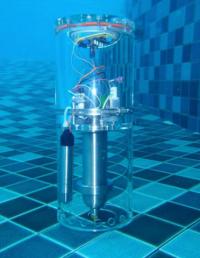The Zero Power Ballast Control (ZPBC), a technology developed by the Physical Acoustics Branch of the Acoustic Division and the Naval Research Laboratory Bioenergy and Biofabrication Section of the Chemistry Division, allows unsupervised underwater sensing with reporting and subsequent surfacing capabilities.
This technology relies entirely on microbial energy harvesting developments. The device’s aim is to produce small and power efficient data harvesting nodes with varying buoyancy. It would be capable of monitoring ocean temperatures with a stay time that ranges between weeks and months and ultimately years. This would provide a much longer term when compared to other mechanisms like the Expendable Bathythermograph.
 The current device is composed of two chambers: the top, "dry " chamber containing the electronics, valves, solenoids, and timers; and the lower chamber, that contains the growth chamber
The current device is composed of two chambers: the top, "dry " chamber containing the electronics, valves, solenoids, and timers; and the lower chamber, that contains the growth chamber
Dr. Justin Biffinger has revealed that preliminary trials had proved to be successful in several ways. The device submerged and surfaced from time to time as designed with the help of hydrogen gas, which was garneted by the microbial inoculums and growth medium. Thus, the device generates sufficient quantity of gas to create buoyancy. When two ZPBC systems were tested, both the rise and fall of the devices were sustained by on-board temperature and pressure sensor data and direct observation. The inoculated gas production vessel, which is the bacterial fuel source, was then joined and the two ZPBC devices were deployed in position off a military pier located in Sattahip in Thailand. They were controlled by mooring lines for a week.
The device utilizes a low power timer or at times the rate of microbial gas generation that needs zero power input. It can be configured alternatively to surface on-demand. Magnetic and acoustic sensors, which are attached to the ZPBC, can be used for detecting, classifying, and monitoring the rise to the surface and then report it utilizing RF or other ways of communication. They would then re-submerge and proceed with the monitoring operations.
The ZPBC, in the future, would offer input for strong modeling of ocean temperatures along with other parameters. It could also be used to provide in-water optical information for improving models for underwater visibilities, diver and target vulnerability assessments, laser penetration depths, refining numerical models and electro-optical system performance predictions.
Scientific applications and Military utility would include use in Anti-Submarine Warfare (ASW), Intelligence Surveillance and Reconnaissance (ISR), Meteorology and Oceanography (METOC), Naval Special Warfare (NSW) and Mine Warfare (MIW). The device can be untethered in future tests by continued prototyping which would include geo-referencing capabilities.
Source: Naval Research Laboratory